Lazio ended the Serie A season in 5th place, securing Europa League football in the last two weeks of the season. After collecting 64 points in the league, 4 fewer than the year before but having gained a spot higher, Maurizio Sarri the former Juventus manager will see his first season as a success. However, when you take a deeper dive, you will begin to see Lazio massively overperformed their underlying numbers.
In terms of expected goals, Lazio were expected to score around 59 goals in the league, although they achieved to score 77 in campaign. This overperformance of 18 goals was clearly down to excellent finishing from key players such as Ciro Immobile and Sergej Milinkovic-Savic. Whilst this is not a criticism of Sarri, this is something that should not be expected to be repeated every year, and a return to the norm will come next year. Lazio had less xG than any team in the top eight, yet scored more goals than every team but Internazionale.
Furthermore, Lazio were expected to concede more goals than eight of the other nine teams in the top half of the table. If teams achieved their expected points, Lazio would be sitting in eighth place, missing out on European football entirely. Lazio games saw 135 goals in 38, averaging 3.6 goals per game. Only games featuring Bordeaux and Borussia Dortmund saw more goals this season among the top 5 European leagues. Whilst these fine margins went Lazio’s way this season, Sarri will have to make changes to make sure he achieves European qualification without having to rely on extremely clinical finishing.
This scout report will feature a tactical analysis of how Maurizio Sarri set up Lazio during the season. It will also feature an analysis of how these tactics caused them to score and concede so many goals.
In Possession
Build Up
Maurizio Sarri likes his teams to build out from the back, through the goalkeeper, and slowly play through the thirds as the team moves up the pitch. They keep a 4-1 build up when the ball is in their third. This is to maintain security on the ball in what would be a dangerous area to lose the ball in. The ball is moved along the back line, with the holding midfielder giving depth to the build up, otherwise it would be too predictable.
In goal kick situations, one of the central defenders will pass the ball to the goalkeeper. This allows the ball to be in a central area, so teams can’t force Lazio to go one way and box them in. During the build up, Lazio aim to escape the press through progressing it in wide areas. The goalkeeper usually waits to attract pressure, before playing a lofted pass over the top to a full back. In those wide areas, is where Sarri shows his creativity in playing through the press with his ingenuity.
As seen in the image below, one of Sarri’s methods to progress, is to bring lots of supporting players to the ball, which draws in opposition players all to one compact area. This leaves lots of space between the midfield and defensive line, where Milinkovic-Savic lurks into and is able to receive the ball under no pressure.
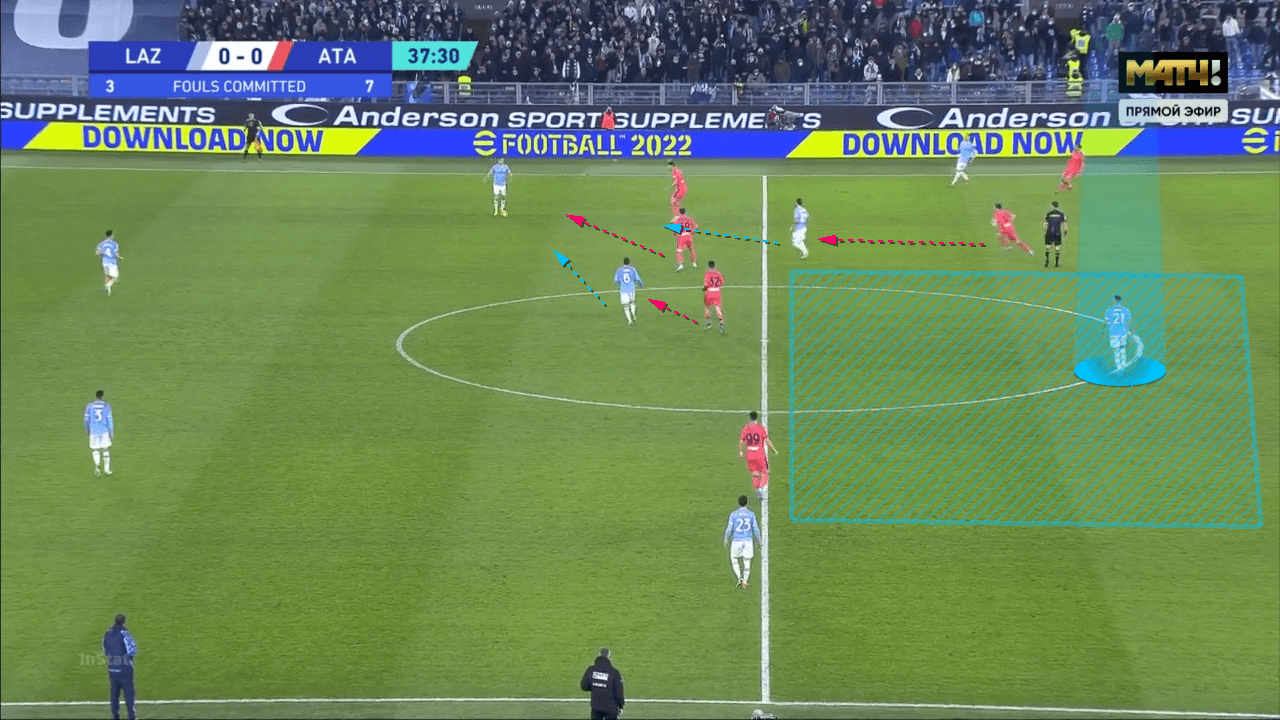
Sarri has also worked on creating 3v2’s in wide areas where the full back, winger and central midfielder can combine to progress the ball thanks to numerical superiority. Working in wide areas is something Sarri prioritises, as opposition players have a dilemma as to whether they should press the ball, and vacate open spaces in the middle of the pitch, or simply let the Lazio players have the ball in a less dangerous position.
Another pattern Sarri has shown, is to move the full backs into central areas. He has done this by making sure the holding midfielder purposely runs into a wide area, dragging his marker away from the centre of the pitch. The image below shows how Lucas Leiva runs to the side so that Elseid Hysaj has space to move into and receive the ball centrally. Receiving the ball in a central area allows Hysaj to have passing options all around him, rather than having the whole right side blocked off by the touchline.
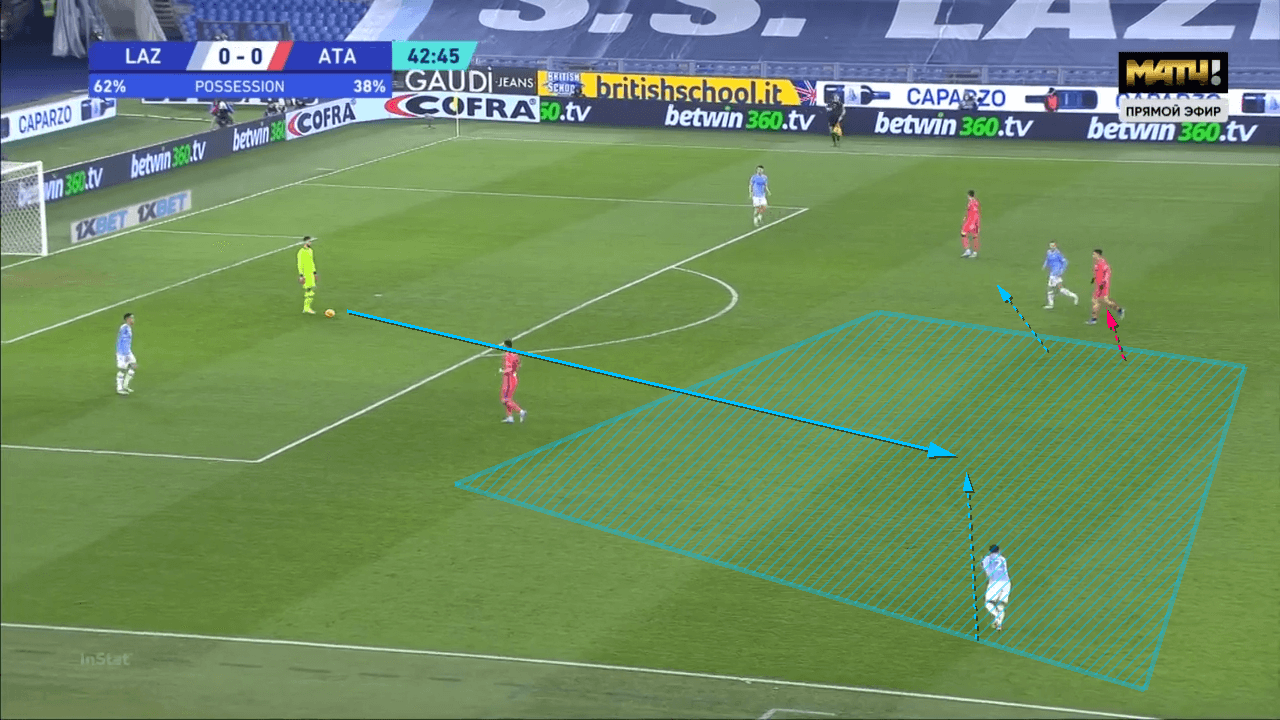
Progression
When a team sits a bit deeper, or when Lazio have successfully played out from the back but too slowly, Lazio stretch the pitch to create gaps in the opposition’s defensive lines. In these situations, Lazio make the pitch as big as possible so that they can progress the ball through central areas. Often, Lazio’s defenders or midfield players will attempt line-breaking passes through the opposition midfield line, as they are slightly distracted by the wider full backs and wingers. Although this may be risky at times and lead to possession turnovers, the reward can be huge as the Lazio front five can turn and run at the opposition’s back four.
The image below shows a slightly different pattern of progressing through middle third. This is a quite common up, back and through pattern where the ball is progressed at a fast pace, although travelling over small distances each time it is played. The first time passes allow Lazio to progress the ball without opponents getting close, a dream for all managers.
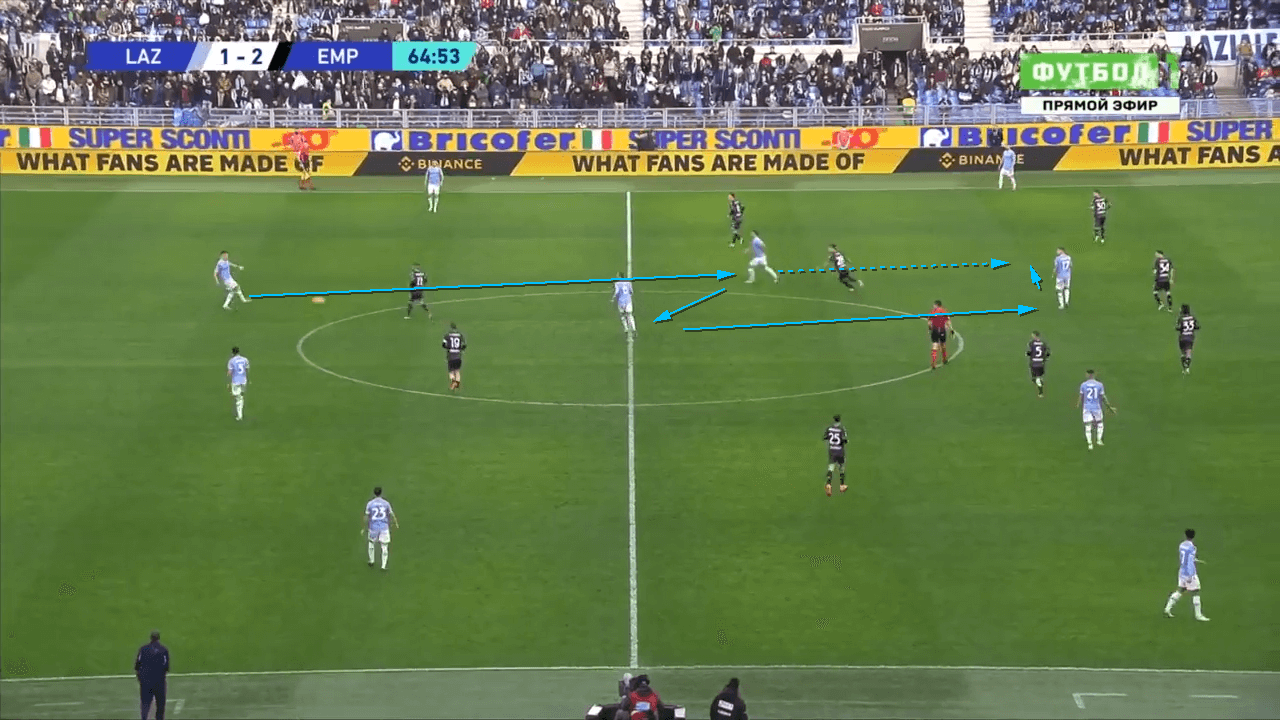
Chance Creation
In the final third, Lazio haven’t been a super creative team as you’d expect by their amazing goal record, but they still showed good plays and combinations which ultimately led them to scoring 77 league goals.
When attacking the opposition’s box, Lazio try and penetrate through wide areas using a 4-3-3. Keeping possession out wide allows them to stretch the back line, in turn providing passing lanes through central areas. The image below shows how the central defenders are preoccupied by the attackers waiting for a cross, whilst the Lazio player makes an underlapping run, attacking the space where he can get an even better crossing opportunity from. When the cross is made from a tighter angle, and closer to the goal, it is easier for the ball to be crossed on the floor, and is easier for the crosses to accurately play the ball to a teammate.
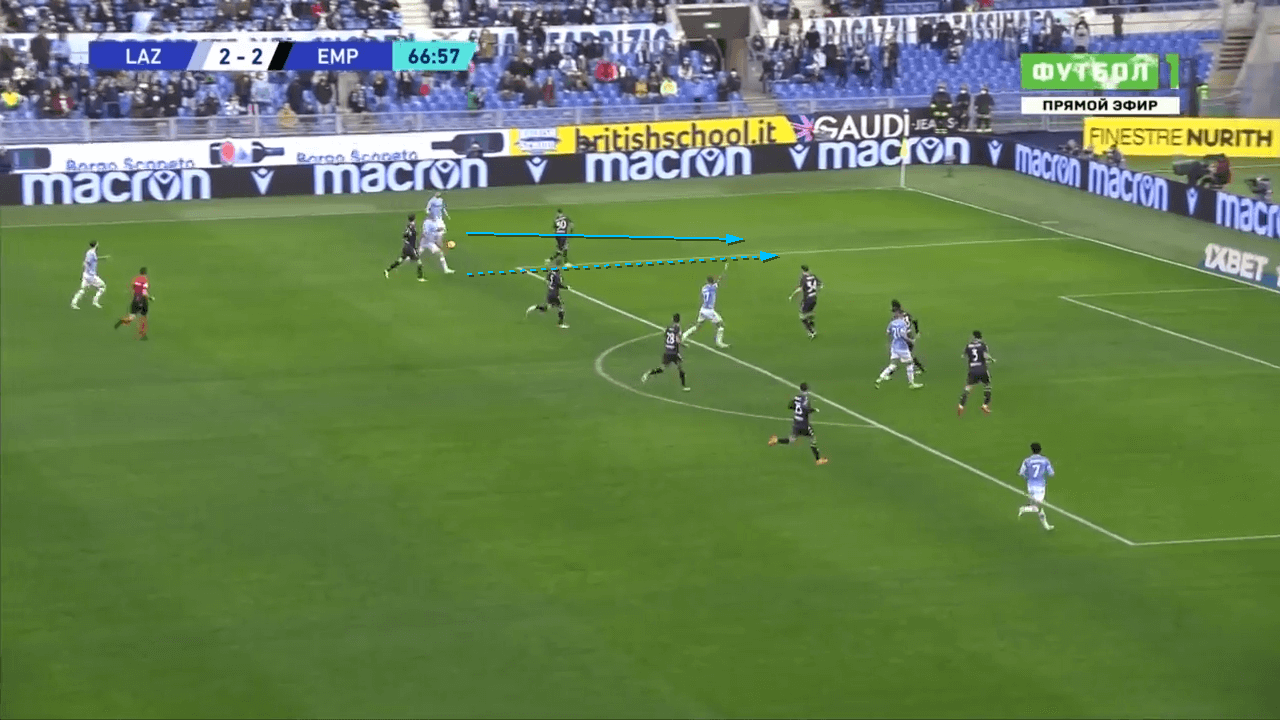
Another key method Lazio used to penetrate the box, was through reverse passes into those similar areas next to the byline. The image below shows how Milinkovic-Savic opens up his body, making it seem as if he is looking to switch the ball. This makes the defenders shuffle across the box, and while they move one way, Milinkovic-Savic passes the ball in the space the defenders just vacated, with a run into that space planned out by Sarri.
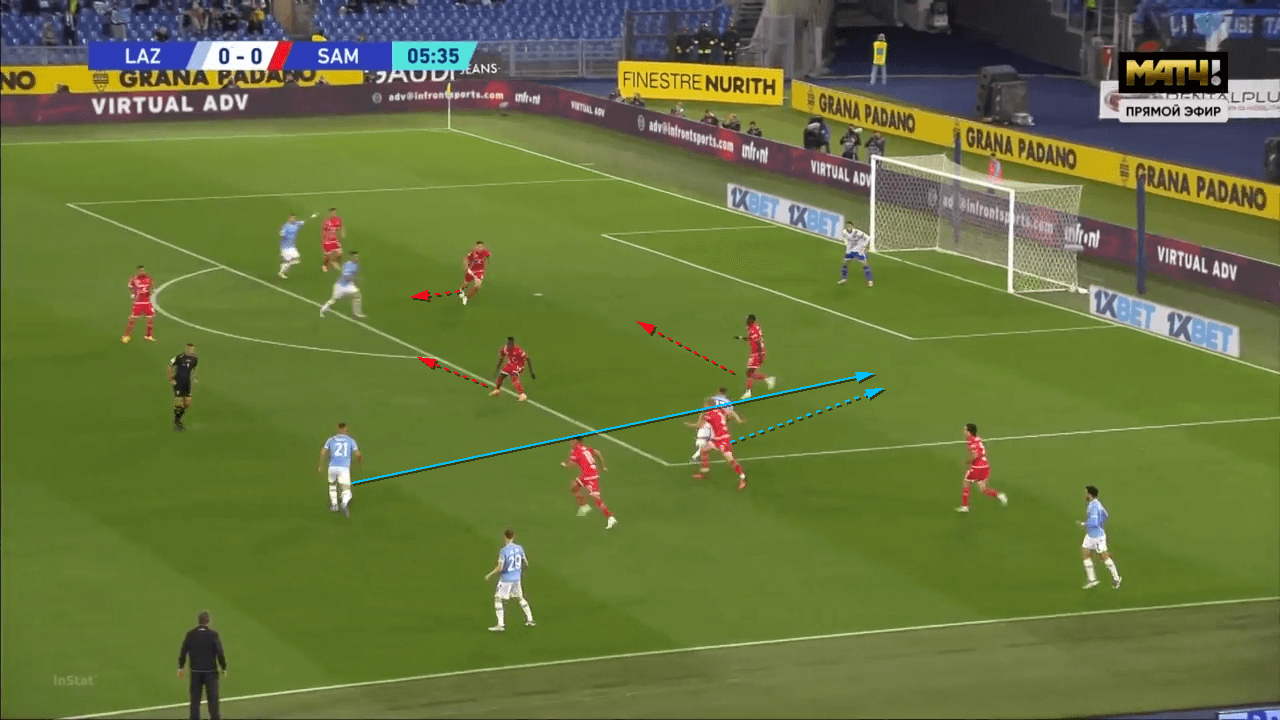
Lazio don’t have the quickest players, but their technical superiority in advanced areas has helped them create intricate combination plays to regularly penetrate opposition defences and score 77 goals. Lazio have also utilised their physical superiority through scoring goals from deep crosses and from set pieces.
Out of Possession
High Press
Lazio attempt to press opposition teams high regularly, however, they usually are most successful when doing so in dead ball situations. When there is a goal kick or throw in, the Lazio players have the time to get close to their opposition and prevent them from playing out the back.
When the ball is in open play, Lazio struggle to implement their press and this is where the chaos comes in. Starting in a 4-5-1 shape, as shown in the image below, Sarri instructs his central midfielders to initiate the press. This causes many problems for the Lazio players. While the wide players ensure the ball doesn’t progress in wide areas, the press from a central midfielder leaves spaces between midfielders and wide players heavily exposed.
Due to the midfielder having to cover a big amount of distance to press the ball, the defenders on the ball have plenty of time to play their pass. By the time the midfielder presses the centre back, the ball is already with another player and the other Lazio players have to scramble to cover the spaces. This leaves a 3v1 in those wide areas where it is very easy for Sampdoria to progress the ball and launch an attack.
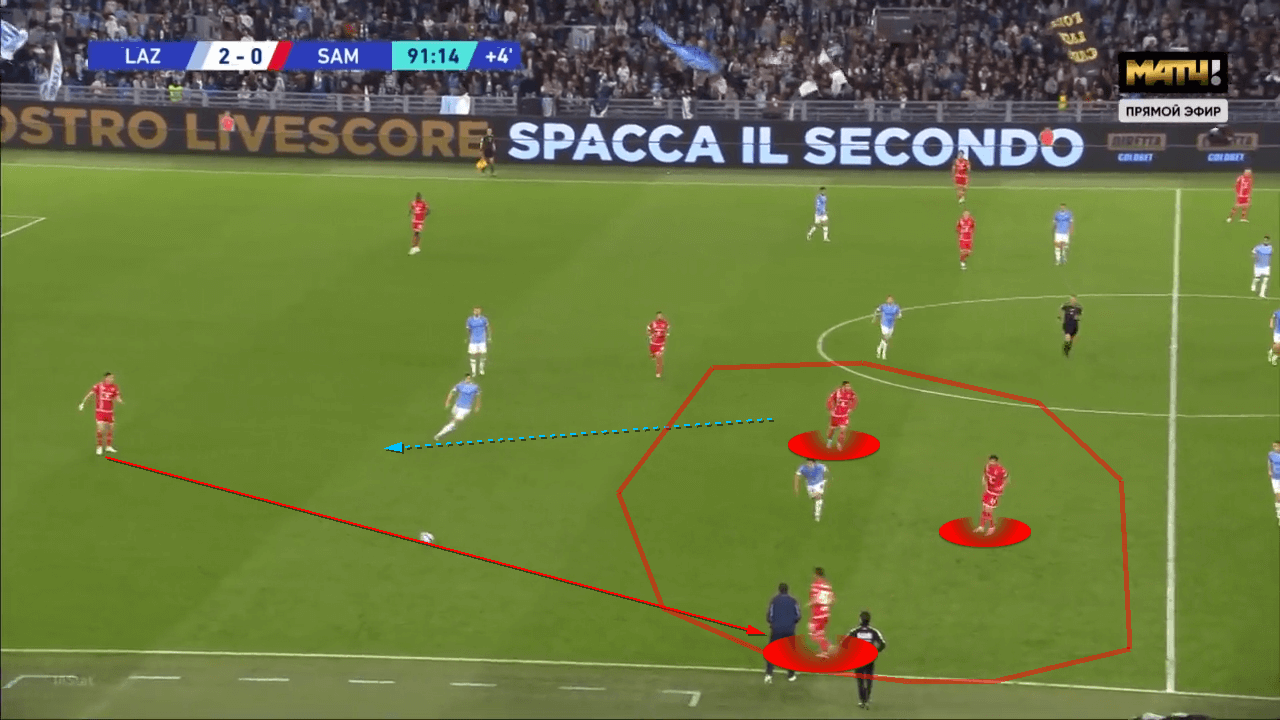
This was a very regular occurrence for Lazio, and a big reason as to why they allowed so many goals compared to the teams around them. Maurizio Sarri has failed at an important aspect of pressing, central compactness. Being so easy to play through, means the press in negligent as you can pass through with ease, and it leaves the defensive line severely outnumbered against opposition attacks.
Chance Prevention
Lazio are tough to break down when they do sit in their 4-5-1 mid block and allow the opposition to have time on the ball. Although this may not be what Sarri wants, as he wants to dominate possession, it is smarter to let the opposition have lots of touches of the ball in their own half, rather than having few touches in extremely dangerous areas.. The image below shows a compact midfield line, meaning there is no gaps where Marseille can pass through. Lazio also maintain a high line which means players like Dimitri Payet have no space to receive the ball between the lines. Marseille are forced to either go down the flanks, with limited passing options, or to play the ball over the top where a keeper is ready to sweep the ball.
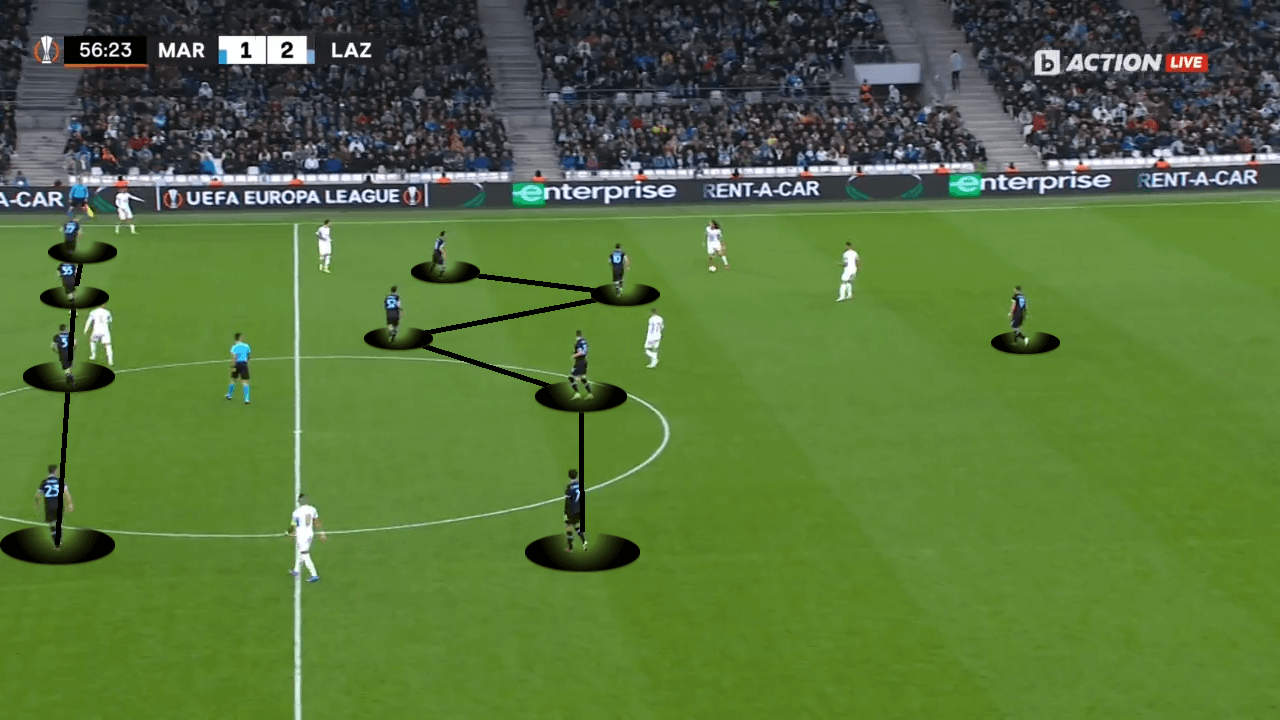
Whilst Lazio do well in deeper areas when they allow the opposition to have the ball, their players do tend to get impatient and repeatedly jump out of position. The image below illustrates the same problem they have when pressing, a midfielder has about 20 yards to cover to press the ball, which gives opposition player lots of time to pick out any pass they like. Impatience has repeatedly cost this side silly goals, and points, and with the potency of the front line, they should be willing to have less of the ball, less chances, but more defensive stability.
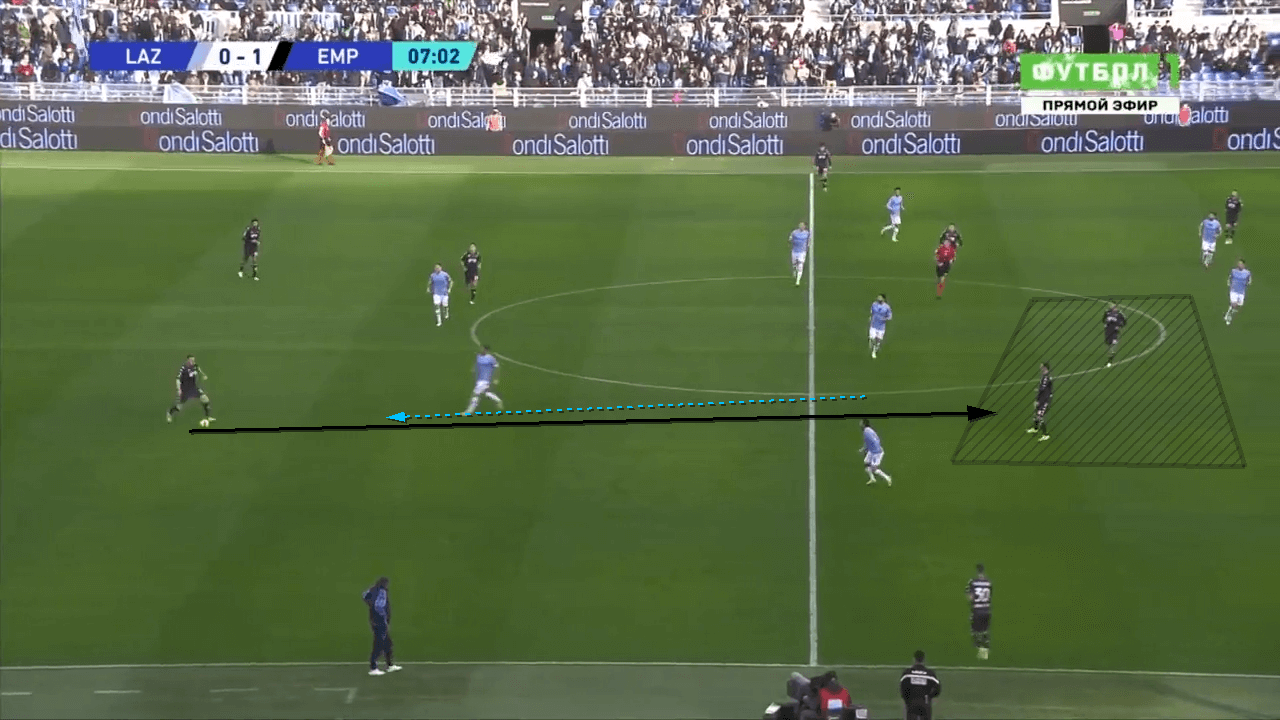
Conclusion
This analysis has clearly shown how Sarri has managed to both improve Lazio attacking output while worsening their defensive quality. Maurizio Sarri has proven through his time as a manager, his ability to structure and coach patterns of play where quick first time passes mean defenders are always chasing shadows.
On the other hand, Sarri has failed to grasp defensive principles that have cost his team goals in most games. Sarri would be better off sitting in a low block, where teams would need to work extremely hard to break them down, or by implementing a better, more effective press. It doesn’t matter which, but if Sarri refuses to change, his Lazio side will continue to leak goals and it will cost them both domestically, and in Europe next year.






Comments